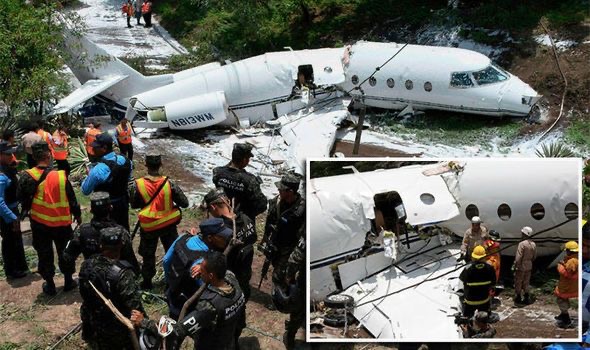
Chaos unfolded at Toncontín International Airport in Tegucigalpa, Honduras, when a private jet skidded off the runway and broke in half after a crash landing. The dramatic accident, which left at least six people injured, sent emergency crews rushing to the scene as thick smoke billowed from the wreckage. Miraculously, all passengers and crew survived despite the violent impact and extensive damage to the aircraft.
According to local authorities, the private jet, a Gulfstream G200, had taken off from Austin, Texas, and was attempting to land at one of the world’s most notoriously difficult airports. Toncontín’s short runway, surrounded by mountains and dense urban areas, has long been considered one of the most challenging for pilots. Witnesses reported seeing the plane overshoot the runway before splitting in two and sliding into a nearby road. The impact caused sparks and flames as debris scattered across the tarmac and surrounding area.
Firefighters, paramedics, and airport rescue teams responded within minutes, battling small fires and carefully extracting passengers from the wreckage. Emergency workers used ladders and stretchers to remove the injured, many of whom were dazed but conscious. “It’s a miracle anyone survived,” one airport firefighter said. “When we arrived, the fuselage was split open, but we could hear voices inside.”
Authorities confirmed that at least six people were injured, including both pilots and several passengers. All were transported to local hospitals, where they were reported to be in stable condition. None of the injuries were considered life-threatening. Honduran President Juan Orlando Hernández expressed relief on social media, thanking rescue teams for their swift action and confirming that all aboard were safe. “We must recognize the quick response of firefighters and medical personnel who prevented a tragedy from becoming worse,” he wrote.
Images from the scene showed the plane’s nose resting on a grassy slope, its fuselage twisted and broken near the middle. The tail section remained partially intact, while the cockpit appeared severely damaged. Power lines near the airport were knocked down in the crash, cutting electricity to parts of the capital for several hours. Airport operations were temporarily suspended as investigators began examining the wreckage.
Early reports suggest that poor weather and possible mechanical issues may have contributed to the crash. However, officials from Honduras’s civil aviation authority stated that a full investigation is underway to determine the exact cause. The flight crew will be interviewed as soon as they are medically cleared, and data from the aircraft’s black box will be analyzed.
Despite the terrifying scene, the outcome could have been far worse. Toncontín has a history of fatal crashes due to its short runway and steep approaches, but advances in safety procedures and improved emergency response have reduced risks in recent years. This incident serves as a reminder of the hazards faced by pilots landing at airports with challenging terrain.
As the wreckage was cleared and the airport prepared to reopen, locals gathered near the site, expressing gratitude that no lives were lost. For many, the survival of all on board felt nothing short of miraculous—a rare bright moment in an otherwise frightening day in Honduras’s capital.


